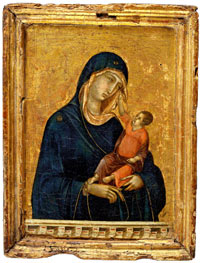Duccio’s Madonna and Child
 The Metropolitan Museum of Art recently purchased a painting called Madonna and Child by Duccio di Buoninsegna. The Met paid $50 million for the early Renaissance piece, more than they’ve paid for any single acquisition to date. The New Yorker has the story of how they came to own the last Duccio in private hands. In the article, Calvin Tomkins explains the reason for the painting’s importance:
The Metropolitan Museum of Art recently purchased a painting called Madonna and Child by Duccio di Buoninsegna. The Met paid $50 million for the early Renaissance piece, more than they’ve paid for any single acquisition to date. The New Yorker has the story of how they came to own the last Duccio in private hands. In the article, Calvin Tomkins explains the reason for the painting’s importance:
Small as it is, the painting has a powerful presence. It captures the eye from a distance, and commands, up close, something like complete attention. Holding the Christ child in her left arm, the Virgin looks beyond him with melancholy tenderness, while the child reaches out a tiny hand to brush aside her veil. Centuries of Byzantine rigidity and impersonal, hieratic forms are also brushed aside in this intimate gesture. We are at the beginning of what we think of as Western art; elements of the Byzantine style still linger—in the gold background, the Virgin’s boneless and elongated fingers, and the child’s unchildlike features—but the colors of their clothing are so miraculously preserved, and the sense of human interaction is so convincing, that the two figures seem to exist in a real space, and in real time. Candle burn marks on the frame, which is original, testify to the picture’s use as a private devotional image. It is dated circa 1300.
I had the good fortune to stumble across the Duccio at the Met a few weeks ago (I was there for the Diane Arbus exhibition and passed it by accident on the way to another part of the musuem). What struck me at the time was a certain oddity of the piece…almost like it wasn’t what they’d said it was but magical all the same. I know Jack about art[1], but after reading more about Madonna and Child, it probably seemed odd to me because it’s a transitional piece, not quite Renaissance but not quite Byzantine either. The piece is a thin slice of a phase transition that had barely begun, a moment frozen from when the artists of the day were collectively working out how a Renaissance painting would eventually differ from earlier European styles and represent the wider cultural changes then occurring. Marco Grassi writes in The New Criteron:
More importantly, the artist places the Virgin at a slight angle to the viewer, behind a fictive parapet. She gazes away from the Child into the distance while He playfully grasps at Her veil. One must realize that every aspect of this composition represents a departure from pre-existing convention. With these subtle changes, Duccio consciously developed an image of sublime tenderness and poignant humanity, almost a visual echo of the spiritual renewal that St. Francis of Assisi had wrought only a few decades earlier.
More more on Duccio, check out his biography on Wikipedia and some collections of his work (1, 2, 3), including other Duccio representations of the Virgin and Child),
[1] I wish I’d taken an art history class in college, but my 18-yo self wasn’t that interested.





Stay Connected